If I asked somebody what their rarest Pokémon was, I’d probably get answers like their Level 100 Charizard from Red/Blue, perhaps a Mew from the 20th Anniversary event distribution or maybe a shiny Geodude found by sheer chance. If you asked me though, I would show you a seemingly bog-standard Inkay.
Except this Inkay knows Happy Hour, a move it can’t normally learn, and more importantly it was only available from visiting real-life Pokémon Centres in Japan during late 2013, right after Pokémon X and Y launched. Nowadays, you’d be hard pressed to find somebody with the same Inkay.
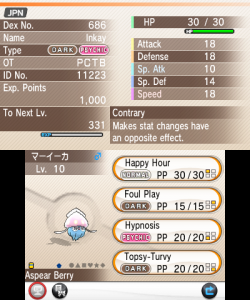
PCTB stands for “Pokemon Centre Tokyo Bay”, which had just opened recently.
Not just the Inkay, my “rare” Pokémon collection is filled with similar odds and ends, half of which look completely unexciting to most Pokémon trainers. Yet the full collection is probably worth a minor fortune if I could ever bring myself to sell it, which I won’t because they’re my treasures!
You see, these Pokémon are all “event Pokémon“, obtained via event distributions only. Your typical event Pokémon include Mythical Pokémon such as Mew, Celebi, Jirachi, etc. But they can also be Legendary Pokémon, Shiny Pokémon or Pokémon with unique moves–or a combination of all these.
Event Pokémon can even include completely normal Pokémon as well. What’s important is that event Pokémon exist to celebrate a special occasion and they can only be obtained for a limited period of time. Which is where the novelty of collecting event Pokémon comes from.
In the Pokémon games, you’re encouraged to catch ’em all, but even though there are over 800 Pokémon, some of which are much harder to find than others, eventually anyone can collect them all (theoretically, anyway). Event Pokémon are different though, since they’re not available forever.
In a sense, event Pokémon can be considered limited edition items. Because of this appeal, there are many fans–and even whole communities–dedicated to collecting and trading event Pokémon. Some of whom are extremely serious about their hobby, myself included.
Many go to great lengths to secure a coveted event Pokémon, making long trips to places with an event distribution, forging long-lasting friendships with Pokémon traders living in countries with exclusive distributions and spending hours a day bartering for the best deals for their event Pokémon.
6gen & 7gen pic.twitter.com/qQhNw5DUSa
— Hamkichi (@yu_Itokichi) September 19, 2017
For some, it’s not enough to just have an event Pokémon. You also need to meticulously prove that your Pokémon is “legitimate“, often by photographing or video-recording the entire process of receiving the event Pokémon or, in extreme cases, proving you were actually at the site of the distribution.
This has become extremely important in recent years since, despite the large number of honest-to-good traders, modifying Pokémon has become increasingly trivial. Unlike goods that exist in real-life, because event Pokémon are virtual, it is all too easy to clone and manipulate them. So a large element of trust is always involved.
Sadly, in some places, this has led to a slow but noticeable decline in trading activity. While it’s exciting to trade with the influx of new traders, there is the burning question at the back of the mind: can I trust him/her? As such, some veterans–especially those burned by scammers–prefer to stick to recognised traders or try to get the Pokémon themselves.
By the by, while some traders and communities abhor cloned event Pokémon, there are others who trade them openly. As a hobby, there is no objectively right or wrong way to enjoy it; it depends on who you talk to. While I personally keep a clone-free collection, introducing clones has many benefits too–namely, it allows an otherwise limited resource to be shared out.
In the eyes of some, the whole event trading biz can seem a little strange. Why spend so much effort for what amounts to a bunch of 0s and 1s? But just because event Pokémon are virtual doesn’t mean they’re worthless. Many people sell or trade items from other games; “value” is all in the eyes of the beholder.
For me, I’ve had loads of great experiences with collecting and trading event Pokémon. I’ve made many new friends from various countries as a result of trying to collect foreign events and I’ve gone to places I’d never would have gone just to get my hands on the hottest new event Pokémon.
As for the event Pokémon themselves, what I particularly appreciate is the “history” behind each one. Primarily, this can refer to the reason for their distribution (like an Infernape to celebrate the Year of the Monkey), as well as the circumstances of their distribution (like a Pikachu given away exclusively from a luxurious spa in South Korea).
It also encompasses the means of how I received the Pokémon in the first place. Obviously, the ones I got myself personally, I have “fond” memories of queuing up at GAME to get the serial codes or dragging myself to the Pokémon Nationals, etc. Others, I remember the time and effort to conduct the trade and the trader I received the Pokémon from.
By now, if you didn’t already, you should have a pretty clear idea of the background of event Pokémon collecting. Perhaps you’ve even been inspired to start your own collection? In any case, how would one get started with collecting? Before you begin seriously, take note: do not expect to get all of them, unless you include clones in your collection.
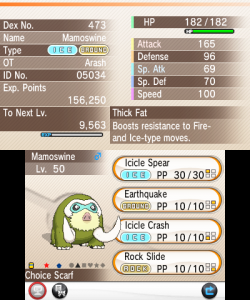
I picked up this Mamoswine from VGC Nationals in Manchester, 2014.
Because quite honestly, with the humongous amount of event Pokémon given out throughout the 20+ years of Pokémon, across the various territories, you are never going to “catch ’em all” if you try to obtain them all via the “intended way” (and that includes trading with like-minded people). This can be a tad disheartening, but it’s important to bear in mind.
Rather, one should move the goal to a level they feel comfortable with. To start with, the goal could be all the Mythical Pokémon. As time passes, this goal can be shifted around to accommodate the projected expansion of one’s collection. Maybe the goal could become all the event Pokémon found in your country during the current generation. Or just stick to your favourites.
Moving on, this is where the real work begins. Every event collector in their life had to have started somewhere. There are two easy ways to start climbing the ladder. The first method, which is applicable all the time, is to breed shinies, especially those with competitive stats and builds. This is a lot easier if you use the TSV/ESV method.
Since this article is about event Pokémon foremost, I won’t delve too much into the method, but basically every single Pokémon egg has a 4-digit value (ESV) encoded into it. If this value matches the trainer’s 4-digit value (TSV), the egg will hatch into a shiny Pokémon. Therefore one can hunt for trainers with matching TSVs to get guaranteed shiny hatches.
In some circles, competitive (built) shinies are the “base currency” of event trading. You will see people offering events for N comp. shinies, where N can be 1 all the way up to 30 or higher. Any higher than this and it becomes unwieldy, both in terms of breeding and trading (good luck trading 100 shinies at once!).
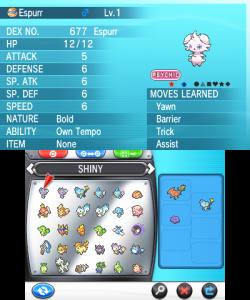
Here’s a box of shinies I bred or received as gifts or payment.
Those who aren’t event traders are often shocked when they discover traditional shiny Pokémon are essentially peanuts in their eyes. However, it makes sense when you consider these shinies can effectively be engineered consistently. Whereas event Pokémon cannot be created yourself and are only available for a set period.
The second method is to farm commonly-available event Pokémon. Such Pokémon include those given out via Internet (Wi-Fi) distribution or as serial codes from game/hobby stores. For the former, one can download the event Pokémon, trade it to a second copy (or Pokémon Bank), erase the game and repeat the process, allowing for near limitless Pokémon.
That said, it’s much easier said than done. In Pokémon Sun/Moon, the earliest opportunity to physically receive your event Pokémon from the delivery man is after 20-30 mins. During that time, you must visit Iki Town twice, battle Hau twice and get the Rotom Dex from the Professor. Multiply that for every Pokémon you download and the repetition quickly sinks in.
For the latter, your mileage may vary, depending on how “nice” the store clerks are. Maybe you’re buddy buddy with them and can get a stack of 50 serial codes on the first day. Or perhaps the clerks are stingy and only give you one code if you can prove you own the game, or worse pressure you to buy or pre-order something.
Anyway, these common events are very nice to have and are generally worth 1 comp. shiny. The benefit of stockpiling such events is that it can often be faster than obtaining the equivalent number of shinies. Say it takes 2-3 hours to breed an egg and hatch it shiny, you could pop out to the shops and get a serial code in 30 mins or do a playthrough in 20-30 mins.
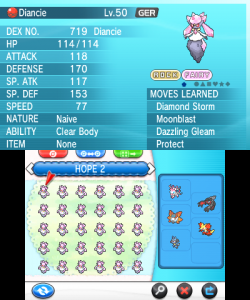
During my heydays, I farmed boxes of Mythicals.
Likewise, the value perception for non-event traders can be whack. As it happens, many of these commonly-available event Pokémon are Mythical Pokémon. So you might think your Marshadow from Gamestop is the hottest thing ever. But try to trade it for a rare Japanese event and you may get laughed at. Then you see people with boxes of Marshadows.
Regardless, the first step is to build up a good stock of comp. shiny Pokémon and/or commonly-obtained event Pokémon. After that, you can start trading up for less common events–and eventually make your way to the highest tier of event Pokémon. Who knows, maybe you’ve eventually get that rare Shiny Jirachi or Shiny Diancie you always wanted.
Those who are a bit luckier (or more determined) can begin by trading the big guns from the very start. Who wants to waste time farming low-value shinies and Wi-Fi events/serial codes, right? There are two ways to start big. One, you are fortunate enough to live in Pokémon heaven: Japan. Or the lesser Pokémon heaven: South Korea.
Very frequently, Pokémon trainers alike bemoan Japan and Korea getting all the cool event Pokémon that the West never gets. So if you can get your grubby hands on these events, you are sorted for life. Especially if you have a Pokémon Centre building nearby–sadly this isn’t applicable to Korea, but they have far rarer events, so it occasionally balances out.
Such events can easily be traded for 10+ comp. shinies a piece, which quickly adds up. Of course, you can’t always choose where you live and it’s not always feasible to relocate, solely for a hobby. The budget alternative is to make friends with Japanese and Korean traders, but even that isn’t an easy task given the language and cultural differences.
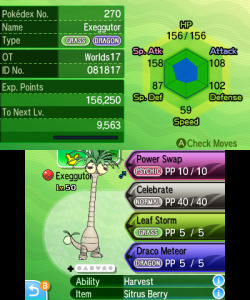
It’s worth having Alolan Exeggutor just for the memes!
Two, try to keep your eyes out for the harder-to-acquire event Pokémon in your country. Every year, the Pokémon World Championships–the gathering of all the best Pokémon trainers–is held somewhere in North America. Each year, they hand out a commemorative event Pokémon, which is worth a lot to event collectors. In 2017, it was an Alolan Exeggutor.
On top of frequently checking the Pokémon websites for news, this method requires some foresight and can be rather hit and miss. It’s also mostly applicable to those living in Europe and North America, where championships and other events are most often held. If you live in, say, Africa or South America, you’re pretty much out of luck.
I could go on forever, but for now, that should be a good starting point into the wonderful world of event collecting. Like all things, the best way to learn the ropes is to just try. Or maybe you’re content with just knowing. Anyhow, if you’ll excuse me, I’m off to plan my trip to grab Shiny Silvally codes from as many GAME stores as possible…